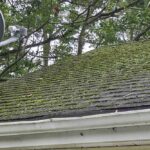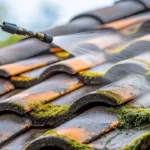In today’s world, embracing sustainable architecture has become increasingly important. One of the key aspects of sustainable building is the focus on eco-friendly roofing options. Sustainable architecture roofing not only contributes to reducing the carbon footprint but also enhances the longevity and efficiency of buildings. As homeowners become more environmentally conscious, the demand for green roofing solutions continues to rise.

What is Sustainable Architecture Roofing?
Sustainable architecture roofing refers to the use of environmentally friendly materials and techniques in constructing roof structures. This approach aims to minimize the impact on the environment while maximizing energy efficiency and durability. By incorporating sustainable practices, architects and builders can create roofs that are both functional and environmentally responsible.
Benefits of Sustainable Roofing
Choosing sustainable roofing options offers a multitude of benefits:
- Energy Efficiency: Sustainable roofs often include features that improve insulation, reducing the need for heating and cooling.
- Environmental Impact: Using eco-friendly materials helps reduce waste and pollution, contributing to a healthier planet.
- Durability: Sustainable roofing materials are designed to last longer, reducing the need for frequent replacements.
- Cost Savings: Over time, energy-efficient roofs can lead to significant savings on utility bills.
Types of Sustainable Roofing Materials
There are several options available when it comes to choosing sustainable roofing materials:
- Recycled Shingles: Made from recycled materials, these shingles offer durability and a reduced environmental footprint.
- Cool Roofs: These roofs are designed to reflect more sunlight and absorb less heat, keeping buildings cooler.
- Green Roofs: Incorporating vegetation, green roofs provide insulation and contribute to urban biodiversity. Learn more about Roof Garden vs Green Roof.
- Solar Tiles: These tiles generate electricity by harnessing solar energy, reducing reliance on non-renewable sources.
Implementing Sustainable Roofing in Your Home
For homeowners interested in adopting sustainable architecture roofing, there are several steps to consider:
Consulting with Professionals
Before making any decisions, it’s essential to consult with architects or roofing experts who specialize in sustainable practices. They can provide valuable insights into the best materials and techniques for your specific needs.
Assessing Your Roof’s Condition
Before installing a sustainable roof, evaluate the current condition of your roof. Addressing any existing issues ensures that the new roof performs optimally.
Choosing the Right Materials
Selecting the appropriate materials is crucial for achieving sustainability goals. Consider factors such as climate, budget, and aesthetic preferences.
Understanding Costs vs. Benefits
While sustainable roofing may have a higher initial cost, it’s important to weigh this against the long-term benefits. Over time, energy savings and reduced maintenance costs can offset the initial investment. For a detailed analysis, visit Cost vs Benefit Green Roofing.
Challenges and Considerations
While sustainable roofing offers numerous advantages, there are also challenges to consider:
Installation Complexity
Some sustainable roofing options, such as green roofs, require specialized installation techniques. Homeowners should work with experienced professionals to ensure proper installation.
Maintenance Requirements
Certain sustainable roofs, like green roofs, may require regular maintenance to ensure the health of the vegetation. Homeowners should be prepared for ongoing care.
Local Regulations
Before installing a sustainable roof, check local building codes and regulations to ensure compliance. Some areas may have specific requirements for sustainable construction practices.
The Future of Sustainable Architecture Roofing
As technology advances and awareness of environmental issues grows, the future of sustainable architecture roofing looks promising. Innovations in materials and design are continually emerging, providing homeowners with more options than ever before.
Emerging Technologies
New technologies, such as solar-integrated roofs and advanced insulation materials, are revolutionizing the roofing industry. These innovations offer increased efficiency and reduced environmental impact.
Increased Adoption
With growing awareness of climate change and environmental sustainability, more homeowners are choosing sustainable roofing solutions. This trend is expected to continue, driving further advancements in the field.
Government Incentives
Many governments worldwide are offering incentives to encourage the adoption of sustainable building practices. These incentives can help offset the costs of installing sustainable roofs.
Conclusion
In conclusion, sustainable architecture roofing is an essential component of building a greener future. By choosing eco-friendly materials and practices, homeowners can contribute to environmental conservation while enjoying the benefits of energy efficiency and cost savings. As the demand for sustainable solutions continues to grow, the roofing industry is poised for exciting advancements that will shape the future of construction.

FAQs
1. What is the lifespan of a green roof?
Green roofs can last anywhere from 30 to 50 years, depending on the type of vegetation and maintenance. For more information, visit Green Roof Lifespan.
2. Are sustainable roofs more expensive?
While the initial cost may be higher, sustainable roofs often lead to long-term savings in energy and maintenance costs.
3. Can I install a green roof myself?
Installing a green roof requires specialized knowledge and skills. It’s recommended to hire professionals for proper installation.
This article contains affiliate links. We may earn a commission at no extra cost to you.








